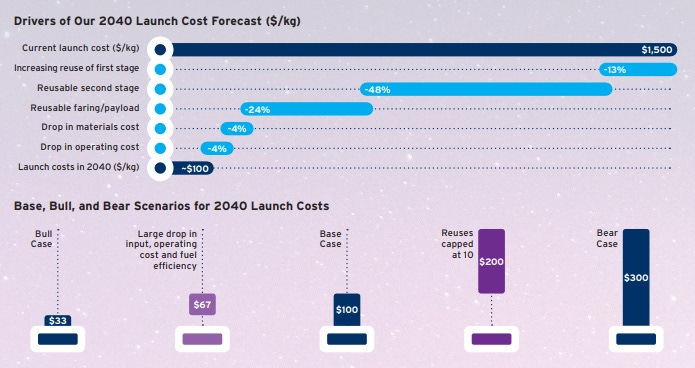🚀 How SpaceX is making a space Mayflower voyage possible: Flashback Friday
The massive decline in launch costs in the New Space Age is helping fulfill a famous thought experiment about asteroid colonization from physicist Freeman Dyson
This essay originally ran Nov. 1, 2024
My fellow pro-growth/progress/abundance Up Wingers,
NASA's Artemis program has spent nearly $100 billion without yet reaching the Moon, plagued by skyrocketing costs and a complex mission design. That’s why Michael Bloomberg comes quite close to arguing for cancellation — "rethink the program in its entirety" — saying Artemis and its pricey Space Launch System are unnecessary since robots can handle lunar tasks and SpaceX offers cheaper alternatives. As the billionaire puts it: "There are government boondoggles, and then there's NASA's Artemis program." Tough stuff.
Mayflower math
In other words, not enough has changed with NASA since physicist Freeman Dyson of Princeton’s Institute for Advanced Study wrote an intriguing essay in 1977 comparing the economics of historical colonization ventures — the Pilgrims' journey to the New World in 1620 aboard the Mayflower and the Mormon migration to Utah in 1847 — with the potential costs of settling the Solar System. Dyson argues that establishing colonies beyond Earth could be made affordable by following these historical private models rather than expensive government programs like Project Apollo.
As Dyson writes in “Pilgrim Father, Mormon Pioneers, and Space Colonists: An Economic Comparison”:
I am saying that the human and economic problems which the space colonists of tomorrow will face are not essentially different from the problems faced by [William] Bradford in 1620 and by [Brigham] Young in 1847. Unfortunately, the extravagant style and exorbitant costs of the Apollo expeditions to the Moon have created in the minds of the public the impression that any human activities in space must necessarily cost tens of billions of dollars. I believe this impression to be fundamentally mistaken. I shall argue that, if we reject the style of Apollo and follow the style of the Mayflower and the Mormons, we shall find the costs of space-colonization coming down to a reasonable level.
By carefully calculating the historical costs of the Mayflower group and the Mormons and converting them to 1975 dollars — this is the bulk of the essay — Dyson suggests that private space colonization inspired by those past efforts would be financially feasible at around $40,000 per person, or around $200,000 today. He then contrasts two space colonization approaches: a $96 billion government project housing 10,000 people at $10 million per person and a smaller $1 million private venture for 23 people at that $40,000 price tag.
Human habitats in space
Both scenarios are based on space settlement concepts from Gerard O'Neill's 1976 book, The High Frontier: Human Colonies in Space. The former, called Island One, would be a complete floating city at L5 — equidistant from Earth and Moon — with synthetic farms, life support systems, and orbital factories. (The book’s images of his proposed space cylinders were the inspiration for the human habitat in the film Interstellar.) O'Neill claimed this project’s massive investment could be repaid within 24 years by selling electricity generated by solar power stations and transmitted to Earth-based receivers in the form of microwave beams.
The other, more minimalist Mayflower 2.0 effort, Dyson writes, would be “a group of young pioneers who save enough money to move out on their own from the L5 colony into the wilderness of the Asteroid Belt. They are going on a one-way trip at their own risk.”
Dyson says the economics of Island One are particularly daunting because the colonists would need so much more gear, 360 tons per person versus two tons for each of the private homesteaders. So Island One would require a massive upfront investment, requiring government assistance:
There is one inescapable difference between Island One and the Mayflower. … The Island One colonist would have to work for 1,500 years to pay his family's share of the costs. This means that Island One cannot by any stretch of the imagination be considered as a private adventure. It must inevitably be a government project, with bureaucratic management, with national prestige at stake, and with occupational health and safety regulations rigidly enforced. As soon as our government takes responsibility for such a project, any serious risk of failure or of loss of life becomes politically unacceptable. The costs of Island One become high for the same reason that the costs of the Apollo expeditions were high. The government can afford to waste money but it cannot afford to be responsible for a disaster.
The DIY settlement, on the other hands, could potentially be self funded:
The cost estimates here describe hopes rather than facts. Nobody can possibly know today whether it will be feasible for a group of twenty-three private people to equip such an expedition at a total cost of a million dollars. Anybody who is professionally qualified to estimate costs will say that this figure is absurdly low. I do not believe that it is absurdly low. All I can say for sure is that a cost in the range of $40,000 per head must be achieved if space-colonization is to become an important liberating force in human affairs. It is no accident that the per capita cost estimates for the asteroid colony turn out to be similar to those of the Mayflower. This is the maximum level of costs at which the space beyond the earth will give back to mankind the open frontier that we no longer possess on this planet.
The miracle of reusable rockets
So where do things stand 50 years later for Dyson’s dream of a private colonization effort into the “open frontier” of space? Well, a lot better than before Elon Musk started SpaceX. In the recent analysis “Space Possibilities for Our Grandchildren: Current and Future Economic Uses of Space” for the European Commission, Alessio Terzi and Francesco Nicoli point out that the “advent of reusable rocket technology (spearheaded by SpaceX in 2016) constitutes a watershed moment” in mitigating the cost constraints that were limiting the economic potential of space.
The EC report notes that launch costs to orbit have plummeted from $87,000/kg in 1960 to about $4,000/kg in 2023 — a more dramatic cost reduction than the steamship revolution that enabled global trade. Following Wright's Law (cost drops predictably as cumulative launches increase), even conservative estimates suggest costs will fall to under $1,000/kg by 2038, potentially transforming the space economy by dramatically lowering barriers to access, the report concludes:
Even under the most conservative scenario, launch costs to LEO using Western providers will be 87% cheaper on average at the end of this decade than they were when the first commercial applications emerged in the 1990s. Under more bullish scenarios, launch costs could be lower than $1,000 per kg by 2038. This underpins our view that the space economy will see a significant acceleration due to falling access barriers, enabling the expansion of supply and demand for all types of space goods.
So things are headed in the right direction. A 2022 Citigroup report is even more optimistic, forecasting launch costs falling to roughly $100/kg by 2040 in their base case through several key cost-reduction drivers, with reusability being the most significant. The Starship rocket could initially launch at $1,600/kg before falling to $100-150/kg through full vehicle reusability, according to the bank. Or even more:
In a best-case scenario, driven by a revolution in materials and operating costs along with fuel efficiency, we estimate launch costs in 2040 could fall further to ~$30/kg, while in a bear-case scenario of rockets still only being reused around 10 times by 2040, we estimate that this will be ~$300/kg.In a best-case scenario, driven by a revolution in materials and operating costs along with fuel efficiency, we estimate launch costs in 2040 could fall further to ~$30/kg, while in a bear-case scenario of rockets still only being reused around 10 times by 2040, we estimate that this will be ~$300/kg.
A dramatic reduction in launch costs to $100/kg or less would fundamentally transform the economics of space colonization, at least as imagined by Dyson. Again, he estimates that each person on the private colonization effort would need two tons of gear at a cost of $10 per pound for a total cost of $40,000 per person. Now, two tons is the equivalent of 1800 kilograms, or $22 per kilogram. Adjusted for inflation, we’re talking around $100 per kilogram — right in the vicinity of the launch costs being discussed in the two reports. And by the way, the decline in launch costs has also helped the economics of Island One work better since it makes space-based solar more feasible in that scenario. From the EC report:
An original study by NASA in 1999 estimated that a launch cost of $200/kg in 1999 dollars (about $377 in 2024 terms) would be needed for beamed solar power to be feasible. However, taking into account process and material costs reduction, which cut costs in other phases of production, a recent ESA 2023 study suggested that a cost of around €1000/kg (about $1100/kg) might be sufficient in closing the case for beamed solar economic feasibility. This would be true by the end of the next decade in both our bullish and very bullish scenarios.
Again, these are just thought experiments. But they illustrate what revolutionary advances are happening with the decline in launch costs, stunning progress that is helping make the boldest dreams of the first Space Age a realistic possibility here in the New Space Age.
On sale everywhere The Conservative Futurist: How To Create the Sci-Fi World We Were Promised
Micro Reads
▶ Economics
The Fives Rules of Finding Talent - Free Press
▶ Business
Manus has kick-started an AI agent boom in China - MIT Tech Review
▶ Policy/Politics
▶ AI/Digital
The Quiet Voices Questioning China’s AI Hype - Bberg Opinion
▶ Biotech/Health
▶ Clean Energy/Climate
Human Intelligence Created the Climate Crisis—But It's Also the Solution - Scientific American Opinion
▶ Space/Transportation
▶ Up Wing/Down Wing
Fireside Chat: The Case for American Optimism - Ronald Reagan Presidential Foundation and Institute
D-Day: The Allied Victory Shows How Tech Goes from Niche to Mass - Bberg Opinion
The NASA Merch Phenomenon Has to Survive the Budget Cuts - Bberg Opinion
The best new science fiction books of June 2025 - NS Opinion
▶ Substacks/Newsletters
In Blue Cities, Abundance Will Require Fighting Labor Unions - Very Serious
Undermining Unity - Risk & Progress
An "abundance" theory of power - Slow Boring
Trump Has an Opportunity to Modernize Agricultural Biotechnology Regulations - Breakthrough Institute










I don't see mars as an interesting target. It has a deltaV of ~ 5Km/sec for both landing and takeoff and all that is there effectively is some water and CO2. There are water and organics in the asteroid belt without the planetary deltaV - and I can potentially use spinning fibers as a mechanical battery to do modest deltaV changes for ougoing and ingoing cargos. The asteroids also have some nickel iron that can be extracted for valuable heavy metals. Also you can use much higher Isp engines in low thrust mode to and from the asteroids.
You can potentially use a gravity anchored fiber to the lunar surface to eliminate the deltaV associated with lunar landing - as long as you are willing to land on the center of the earth facing lunar side. But that would let you try and get meteoric metals and He3 from the lunar surface.